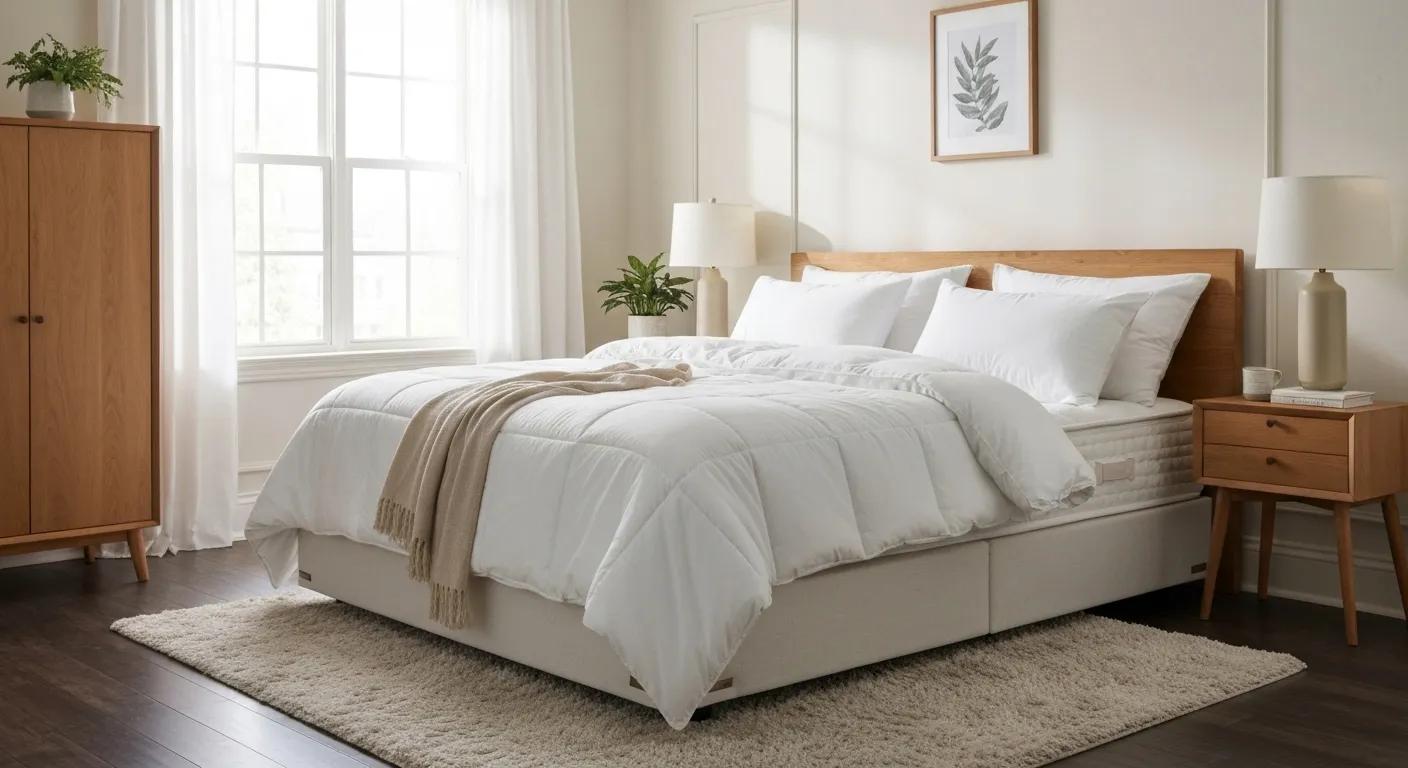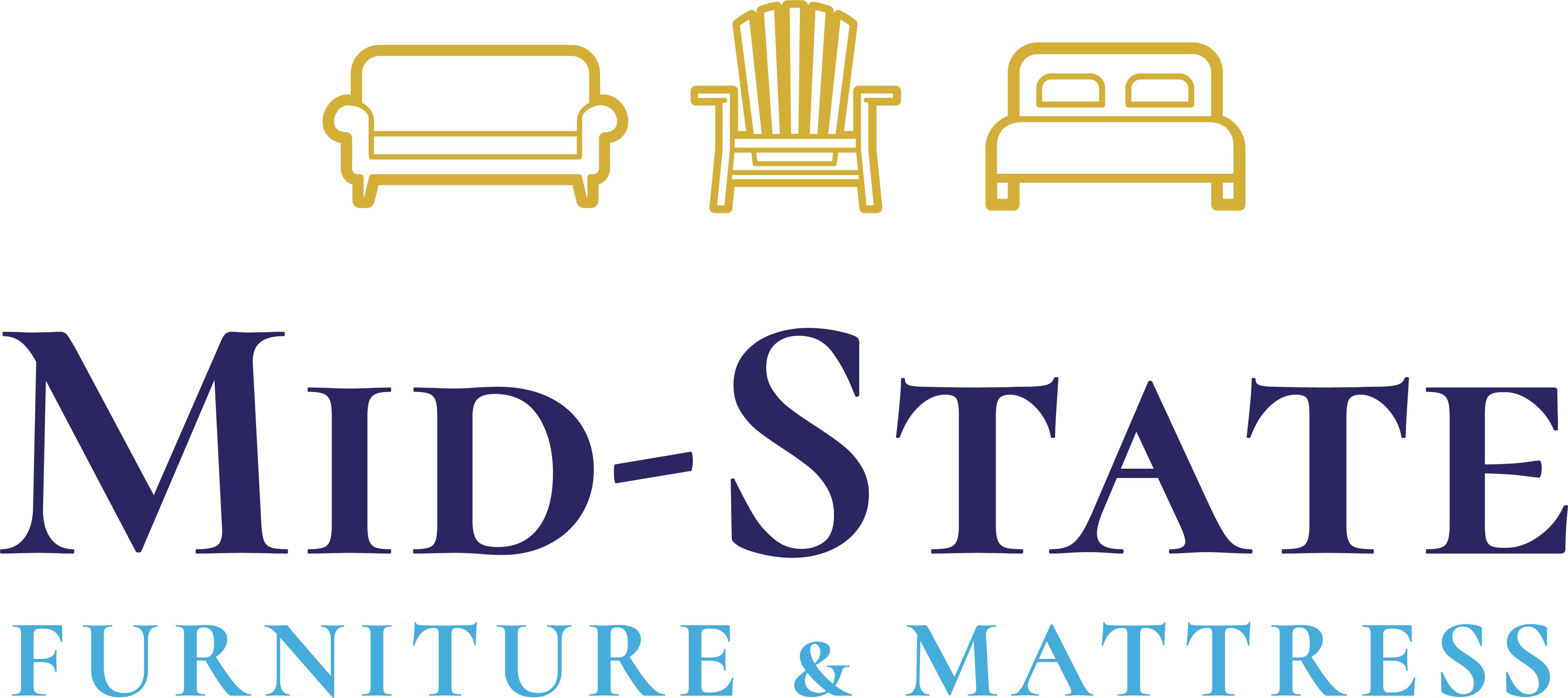Blogs

Blogs
How to Choose a Mattress That Matches Your Sleep Style and Body Type for Perfect Comfort
on Sep 16 2025
Did you know that up to 75 percent of adults wake with morning aches from an ill-fitting mattress? Selecting a mattress that matches your sleep style and body type delivers targeted support, pressure relief, and spinal alignment for truly restorative sleep. This guide covers the best mattresses for side, back, stomach, and combination sleepers; customized firmness by weight category; mattress constructions and materials; the role of firmness in sleep quality; solutions for pain and temperature concerns; shopping considerations including trial periods and local expertise; and emerging trends in smart and eco-friendly designs. Dive into this mattress buying guide with expert tips and local insights from Midstate Furniture & Mattress: Mid-State Home | Quality Craftmanship Timeless Style to find your perfect sleep match.
What Are the Best Mattresses for Different Sleep Styles?
Matching mattress support to your preferred sleep position ensures consistent spinal alignment, targeted pressure relief, and uninterrupted comfort. Side sleepers need contouring layers to cushion hips and shoulders, back sleepers require medium-firm support to maintain natural lumbar curves, stomach sleepers benefit from a firmer surface to prevent lower-back sag, and combination sleepers look for responsive materials that adapt instantly to shifting positions. Explore tailored mattress types for each style below.
Which Mattress Is Best for Side Sleepers to Relieve Pressure Points?
Side sleepers experience peak pressure at the shoulders and hips, so a medium-soft memory foam mattress provides contouring support that cradles these areas and promotes proper spine alignment. Memory foam layers absorb weight through visco-elastic cells, reducing pressure build-up and enhancing blood flow to joint regions.
Key features for side sleepers:
Medium-soft memory foam ensures cushioned contouring at hips and shoulders.
Zoned support layers maintain neutral spine curves.
Motion isolation limits partner disturbance for uninterrupted rest.
A mattress that cushions deep curves sets the stage for better alignment in back-sleeping phases.
How to Choose a Mattress for Back Sleepers to Maintain Spinal Alignment?
Back sleepers need a medium-firm mattress that balances lumbar support with gentle contouring under shoulders and lower back. Zoned coil or hybrid constructions offer firmer support in the midsection and softer transition zones at the shoulders, preserving an S-shaped spinal curve.
Essential attributes for back sleepers:
Medium-firm hybrid design to support lumbar region.
Targeted coil zoning under hips to prevent sink-in.
Top foam layers for moderate pressure relief.
Effective midsection reinforcement readies the mattress for stomach-sleeping support considerations.
What Mattress Firmness Works Best for Stomach Sleepers to Prevent Lumbar Sag?
Stomach sleepers need a firm mattress that resists excessive sinking in the midsection, keeping hips aligned with shoulders to avoid lumbar overextension. High-density polyfoam or firm innerspring profiles maintain a stable, flat sleeping surface.
Stomach-sleeping criteria:
Firm support core prevents lower-back drop.
Low-profile comfort layers limit deep sinkage.
Reinforced edge support for uniform firmness.
A firm foundation for stomach sleepers transitions smoothly into the versatility required by combination sleepers.
Which Mattresses Are Ideal for Combination Sleepers Seeking Versatility?
Combination sleepers require a medium-firm mattress with responsive materials—such as latex or bouncy hybrid coils—that adapt quickly to position changes without sacrificing support. This balance delivers contouring and ease of movement.
Combination sleeper highlights:
Talalay latex or fast-response foam layers.
Pocketed coils for dynamic support and bounce.
Uniform medium-firm feel for consistent alignment.
Responsive constructions ensure transitions across side, back, and stomach positions remain effortless.
How Do You Choose a Mattress Based on Your Body Type and Weight?
Matching firmness to body weight optimizes support and prevents premature sagging or overly firm pressure points. Below are recommended firmness levels and mattress types for different weight categories.
What Mattress Firmness Is Recommended for Lightweight Individuals (Under 150 lbs)?
Mattress Type
Firmness Level
Why It Works
Memory Foam
Soft (2–4 on firmness scale)
Enhances body-hugging contour for pressure relief
Pillow-Top Hybrid
Soft-Medium
Combines coil support with plush cushioning
Plush Latex
Soft
Provides gentle cradle and quick response for movement
A softer profile ensures lightweight individuals experience full benefits of comfort layers.
How to Select a Mattress for Average Weight Individuals (150–250 lbs)?
Mattress Type
Firmness Level
Why It Works
Hybrid Mattress
Medium-Firm (5–7)
Zoning combines support and contour evenly
Memory Foam
Medium
Adapts to curves while preventing excessive sinkage
Innerspring
Medium-Firm
Offers resilient core and moderate cushioning
Balanced firmness accommodates weight distribution without sacrificing comfort.
Which Mattresses Provide Enhanced Support and Durability for Heavier Individuals (Over 250 lbs)?
Mattress Type
Firmness Level
Why It Works
High-Density Foam Hybrid
Firm-Extra Firm (8–10)
Durable foam layers paired with reinforced coils
Innerspring with Euro Top
Firm
Sturdy coil base supports deep compression
Latex Hybrid
Firm
Natural resilience and long-term durability
Robust constructions deliver consistent support and minimize wear.
What Are the Different Types of Mattresses and Their Benefits?
Understanding mattress constructions clarifies how materials deliver targeted support, cooling, and pressure relief.
What Are the Pros and Cons of Memory Foam Mattresses?
Memory Foam Mattress
Pros
Cons
Visco-Elastic Comfort
Excellent pressure relief
Heat retention without cooling gel
Motion Isolation
Limits partner disturbance
Less responsive for active sleepers
Contour Support
Promotes spinal alignment
Slow rebound may feel “stuck”
Memory foam’s pressure-relieving traits segue into hybrid combinations for added versatility.
How Do Hybrid Mattresses Combine Support and Comfort?
Hybrid mattresses layer pocketed coils under foam or latex to deliver balanced support, improved airflow, and pressure relief. Coils offer resilience and edge support while foam layers contour and dampen motion.
Hybrid constructions merge strengths of springs and foam, preparing the path to explore innerspring and latex features.
What Are the Features of Innerspring Mattresses?
Innerspring mattresses rely on steel coils for firm, bouncy support. Traditional Bonnell or pocketed coil systems provide strong edge support, quick response, and superior airflow.
Key innerspring qualities:
Robust coil cores resist sagging.
Breathable design keeps sleepers cool.
Bouncy feel facilitates easy movement.
The buoyant nature of innerspring mattresses contrasts with the organic responsiveness of latex.
Why Choose Latex Mattresses for Natural Responsiveness and Durability?
Latex mattresses combine natural or synthetic latex layers over supportive cores to deliver buoyant cradle, temperature neutrality, and longevity. Talalay and Dunlop latex variants offer different firmness and breathability profiles.
Latex benefits include:
Rapid response for position changes.
Antimicrobial and hypoallergenic properties.
Long service life with minimal sagging.
Latex’s natural resilience introduces a segue into assessing firmness impact on sleep health.
How Does Mattress Firmness Affect Sleep Quality and Comfort?
Firmness directly influences pressure relief, spinal alignment, and temperature regulation, making proper scale selection critical.
What Is the Mattress Firmness Scale and How to Use It?
The 1–10 firmness scale quantifies surface feel: 1 is ultra-soft, 10 is ultra-firm. Select levels based on sleep position and body weight to ensure balanced support and comfort.
Firmness Level
Description
Ideal For
1–3
Plush to Soft
Lightweight side sleepers
4–6
Soft-Medium to Medium
Average weight back or combination sleepers
7–10
Medium-Firm to Extra Firm
Stomach sleepers and heavier individuals
Understanding this scale helps narrow choices before testing options in person or online trials.
How Does Firmness Impact Pressure Relief and Spinal Alignment?
Firmer surfaces resist deep compression, preserving neutral spine angles and preventing hip or shoulder droop, while softer surfaces cradle curves to reduce joint stress. Optimal firmness maintains alignment from head to pelvis.
Pressure management and alignment work together to reduce muscle tension and minimize nighttime tossing.
Effect of different mattress designs on promoting sleep quality, pain reduction, and spinal alignment in adults with or without back pain; systematic review of controlled trials
A systematic review of controlled trials published since 2000 found that a medium-firm mattress, especially one that is custom inflated (self-adjusted), is optimal for promoting sleep comfort, quality, and spinal alignment. The review analyzed 24 articles and deemed their methodological quality moderate to high.
This research supports the article's emphasis on medium-firm mattresses for overall sleep quality, pain relief, and proper spinal alignment, which are central themes throughout the guide.
What Firmness Levels Are Best for Different Sleep Styles and Body Types?
Matching firmness to individual needs ensures both support and comfort:
Side sleepers (soft to medium-soft).
Back sleepers (medium-firm).
Stomach sleepers (firm to extra-firm).
Lightweight individuals (soft).
Average weight sleepers (medium-firm).
Heavier individuals (firm-extra firm).
Precise firmness selection sets the foundation for addressing pain-relief requirements.
How Can You Address Specific Health Concerns When Choosing a Mattress?
Tailoring mattress features to health issues such as back pain, joint pain, overheating, or allergies maximizes therapeutic benefits.
Which Mattresses Are Best for Back Pain Relief and Lumbar Support?
What type of mattress should be chosen to avoid back pain and improve sleep quality? Review of the literature
A systematic literature review of articles published until 2019 concluded that medium-firm mattresses offer advantages for individuals with non-specific low back pain, improving sleep quality and reducing the risk of developing back pain. The review included 39 qualified articles and found that a medium-firm mattress promotes comfort, sleep quality, and spinal alignment.
This research directly supports the article's recommendations regarding mattress firmness for back pain relief and improved sleep quality, particularly highlighting the benefits of medium-firm options.
Key elements for back pain relief:
Zoned support under lumbar region.
Medium-firm core to prevent sagging.
Pressure-relieving top layers.
Targeted support reduces strain on spinal discs and prepares sleepers for shoulder and hip pain solutions.
How to Choose Mattresses for Hip and Shoulder Pain?
Memory foam or gel-infused comfort layers soften high-pressure zones at hips and shoulders, while a supportive base prevents deep sinkage.
Critical features for joint pain:
Soft to medium-soft top foam.
Zoned coils or reinforced zones under heavy areas.
Adaptive materials for even weight distribution.
Joint-friendly designs naturally transition into cooling technologies for hot sleepers.
What Cooling Mattress Technologies Help Hot Sleepers Sleep Better?
Cooling gel foams, breathable latex, phase-change covers, and open-coil constructions wick heat and promote airflow to regulate sleeping temperature.
Cooling innovations include:
Gel-infused memory foam.
Perforated latex layers.
Moisture-wicking, breathable covers.
Hybrid coil cores for air circulation.
Temperature management blends seamlessly into organic and allergy-friendly mattress options.
What Are Allergy-Friendly and Organic Mattress Options?
CertiPUR-US-certified foams, organic latex, and natural fiber covers such as cotton or wool resist allergens, mold, and chemical off-gassing for healthier indoor air.
Organic mattress benefits:
Hypoallergenic, antimicrobial surfaces.
Reduced chemical exposure.
Improved indoor air quality.
Clean-sleep materials complement local expertise when making your final purchase choice.
What Should You Consider When Shopping for a Mattress?
Evaluating durability, trial periods, warranties, and local service ensures a confident investment in sleep health.
How to Evaluate Mattress Durability and Investment Value?
Assess foam density, coil gauge, and edge-support design to predict lifespan; higher-density materials and sturdy constructions typically last 7–10 years.
Durability criteria:
Foam density ≥1.8 lb/ft³ for longevity.
Heavy-gauge coils for sustained support.
Reinforced edges to prevent roll-off.
Long-term performance sets up the importance of trial periods and warranties.
What Are Mattress Trial Periods and Warranties You Should Know?
A generous trial period (90–120 days) allows real-world comfort testing, while warranties covering sag beyond 1 inch and manufacturing defects protect your purchase.
Key trial and warranty terms:
At least 90-day comfort trial.
Full refund or replacement options.
10-year or longer limited warranties.
Understanding these guarantees leads into the value of local expertise and personalized service.
How Does Local Expertise and Service Enhance Your Mattress Buying Experience?
Local retailers like Midstate Furniture & Mattress combine hands-on product trials, personalized comfort assessments, flexible financing options, and prompt delivery with professional setup. Access to brands such as Tempur-Pedic and Stearns & Foster plus 0 percent interest plans streamlines the path to better rest.
Local guidance ensures you select the right mattress for your sleep style and body type without second-guessing.
What Are the Latest Trends and Innovations in Mattresses?
Emerging technologies and sustainability trends are reshaping comfort, convenience, and environmental impact in the mattress industry.
How Are Smart Mattresses and Cooling Technologies Improving Sleep?
Smart mattresses integrate sensors to track sleep metrics, adjust firmness automatically, and regulate temperature zones, enhancing personalized comfort and health insights.
Smart mattress features:
Sleep-stage monitoring.
Automatic firmness adjustments.
Dual-zone temperature control.
These advancements lead the shift toward eco-conscious mattress designs.
Why Are Sustainable and Eco-Friendly Mattresses Gaining Popularity?
Organic latex, plant-based foams, recycled steel coils, and biodegradable materials reduce environmental footprint while offering non-toxic, chemical-free sleep surfaces valued by health-conscious consumers.
Sustainability attractions:
Renewable natural latex.
Certified organic covers.
Recyclable components.
Green innovations converge with best practices for mattress replacement frequency.
How Does Mattress Replacement Frequency Affect Sleep Health?
Replacing a mattress every 7–10 years maintains optimal support, hygiene, and comfort, as materials naturally degrade and lose resilience over time.
Timely replacement benefits:
Consistent spinal support.
Reduced allergen buildup.
Improved sleep quality.
Regular renewal of your sleep surface ensures every mattress upgrade builds on long-term health and comfort.
A well-matched mattress transforms nightly rest into a foundation for daily performance and well-being, guiding you from sleep style and body type considerations through material choices, health solutions, and local expert support. With these insights, you’re ready to explore Midstate Furniture & Mattress’s curated selection, test sleep-style recommendations in person or online, and invest confidently in your best night’s sleep.

